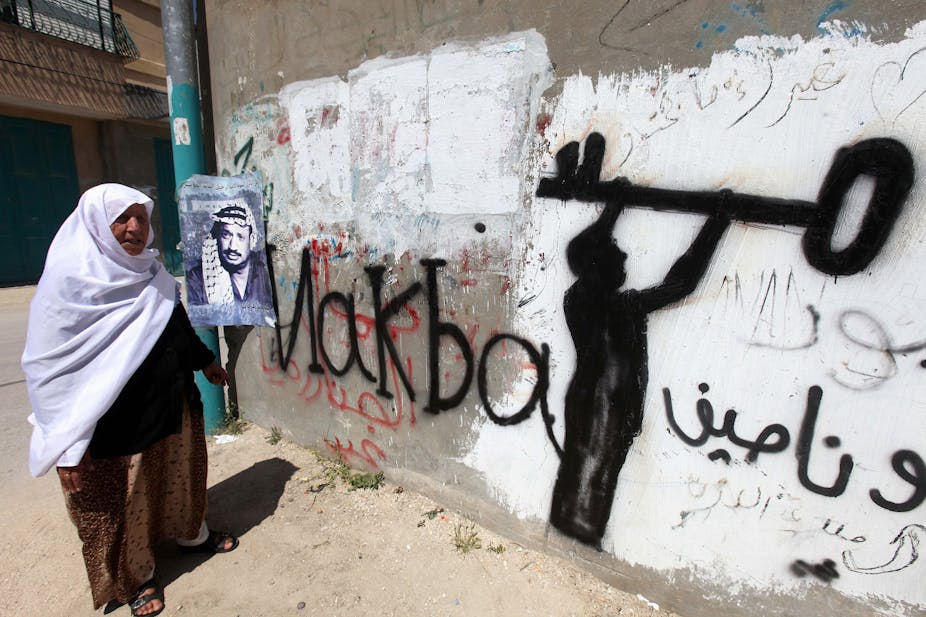This year Nakba Day marks 66 years since the displacement of Palestinians prior to the establishment of the state of Israel. The passing of an-Nakbah (literally, “the Catastrophe”) arrives amidst failed peace talks, ongoing illegal settlement construction and as the security pact between the two parties falters.
When the US special envoy for Israeli–Palestinian negotiations, Martin Indyk, attributed the failure of the nine-month round of peace talks to both parties, his conclusion was based on the unfulfilled commitment by Israel to release a group of Palestinian prisoners, renewed expansion of the settlements and the Palestinian application to join 15 international conventions and treaties, including the UN Convention Against Torture and the Convention on the Rights of the Child.
The bid to join further conventions prompted the release of the fourth and final group of 26 Palestinian prisoners to be shelved – and last Sunday, Israel’s ministerial committee approved a bill that could deny amnesty to Palestinian perpetrators of attacks, a move that has attracted criticism from Israeli chief peace negotiator Tzipi Livni and the centrist party, Yesh Atid.
Coupling the recent absence of tangible progress with 66 years of the same, the shift towards the UN by the Palestinians is not a surprising one. As Palestinian president Mahmoud Abbas said: “All we get from the Israeli government is talk.”
The outlook on the ground is equally uninspiring: according to B’Tselem, by the end of last month 6,354 Palestinian security detainees and prisoners were held in Israeli prisons, 196 of them children. The release of a report by Defence for Children International (DCI) revealed that 95.9% of children had been denied access to legal representation and 76.5% had been subjected to verbal abuse, humiliation and intimidation.
Seeds of strife sewn
The role of the child in conflict and peacebuilding is often overlooked; young adults emerging from a childhood marked by detention and occupation are likely to carry the trauma for years thereafter. Likewise, the militarisation of childhood presents an equally negative development and one for which both sides bear culpability.
As Israel marked her independence on May 6, celebrations featured street and beach parties, fireworks and games. In the settlement of Efrat in the West Bank, however, children simulated the throwing of hand-grenades, “played” with machine guns and crawled under faux barbed-wire. The scene is not new: during the 2006 Lebanon War, the image of children writing on shells (“From the children of Israel, to the children of Lebanon, with love”) was particularly poignant, while a 2012 documentary film by Itamar Rose, featured children visiting an army museum. When asked what they imagined while sitting in a tank, the response was stark: “I picture a dead Arab.”
The counter-argument to this cites the instances in which Palestinian children have been caught enacting similar scenes. And therein lies the problem: the glorification of armed violence affects children on both sides and when coupled with the legacy of over 66 years of unrest, the possibility of a future free from grievance becomes increasingly remote.
In 2000, Edward Said observed that in the “inflamed atmosphere of military occupation and injustice it is perhaps too much to expect these acknowledgements and recognitions to take place. But […] at some point they must”.
As nuanced as the role of children, the act of acknowledgement is an element of reconciliation that must take place before Palestinians and Israelis can commit to a lasting peace. Part of this is the recognition of each side’s memories and traumas.
Earlier this week, the dean of Haifa University turned down a request by Palestinian students to commemorate Nakba Day on campus. This is not a new move; in 2012 the commemoration was cancelled three hours before the event. When this year’s proposal was rejected, the students opted for a quiet rally and the group sat in a circle, without flags or banners. As the students commemorated, loud trance music was played – a dance party had been approved by the University and the beats played over the group, who continued to observe the commemoration.
The inability to recognise the memories and narratives of each side allows fissures, old and new, to exist and resonates from the top down. This week’s sentencing of the former prime minister, Ehud Olmert, to six years imprisonment is a case in point – for both sides. As Haggai Matar noted, Olmert is going to jail for the wrong crimes, for while bribery is the charge, he bears a greater stain:
More than a thousand Lebanese, a third of them civilians, and 165 Israelis, a quarter of them civilians, were killed in the Second Lebanon War. […] Operation Cast Lead took the lives of nearly 1,400 Palestinians, more than half of whom were civilians, and nine Israelis, of whom three were civilians.
The question remains: had Olmert not been collared for bribery, would he have been held accountable for these deaths? Possibly not.
These wounds are more than 60 years old. The intermittent stabs and scratches have accumulated over the decades and remain open, untended. However, there are those who challenge the discourse of despondence: organisations such as Children of Peace bring together Palestinian and Israeli children to engage in grassroots peacebuilding projects; Combatants for Peace works with former Palestinian and Israeli combatants, not just building links between the soldiers, but with communities through school, theatre and recreational projects. Similarly, in 2007 students at the University of California at Irvine established the Olive Tree Initiative in a bid to ease tensions on campus regarding the Israeli-Palestinian conflict.
The year 1948 has – and always will be – regarded subjectively. Differences aside, the future, for the most part, is viewed with the same desires in mind: stability, understanding and a unity that can be trusted.

